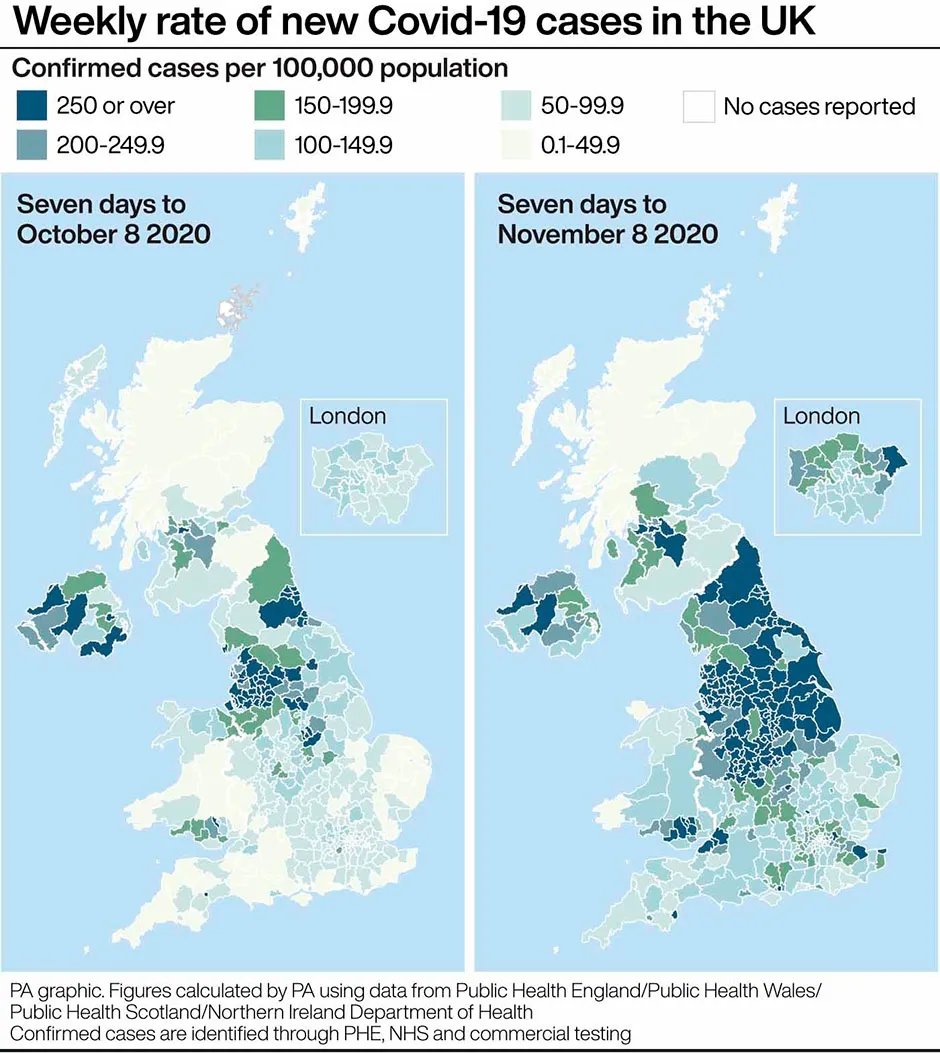Lockdown measures currently in place in England are likely to take the coronavirus R number below one but returning to the previous tiered system will cause infections to rise back to levels seen early in November, Government scientists have said.
In a set of new documents released by the Scientific Advisory Group for Emergencies (Sage) on Friday, the experts said that if the four-week lockdown measures are well adhered to, the number of hospital admissions and deaths can be expected to fall until at least the second week of December.
But they added a longer-term outlook will depend on both the nature of non-pharmaceutical interventions implemented after 2 December, when the lockdown measures are expected to be lifted, and policies over the festive period.
A document, dated 4 November, said: “If England returns to the same application of the tiering system in place before 5 November, then transmission will return to the same rate of increase as today.”

On 12 October, Prime Minister Boris Johnson announced England would be placed into “medium”, “high” and “very high” alert levels – or Tier 1, 2 and 3 – involving varying restrictions aimed at tackling the virus.But as the number of coronavirus infections continued to rise, a four-week lockdown was introduced on 5 November.
The number of new daily cases across the UK is currently thought to be between 55,000 and 81,000.Experts believe R – which represents the number of people a COVID-19 positive person goes on to infect – is below one in some places, particularly in the north west of England.
Meanwhile, another Sage document suggests the national outbreak is still at a “high and controlled” phase.If this remains the case, or if the outbreak returns to current levels after the lockdown, Sage has advised there is “little to no scope for loosening of social distancing rules over Christmas”.
But if prevalence is “low and controlled” and R is “well below one” for some time, the experts say there may be a “greater potential for loosening of social distancing rules for a limited period of time during the festive period”.
Read the latest coronavirus news:
- Sputnik V COVID-19 vaccine is 92 per cent effective, Russia reports
- Two-thirds have long COVID symptoms 7 weeks after hospital discharge
- Everything you need to know about the Pfizer coronavirus vaccine
The Government scientists said if R is reduced to 1.1 or lower for some time, there may be a “limited accumulation of population immunity”. This, they say, will start reducing the average population susceptibility to the virus and slow down transmission.
“When R is 1.1, only 9 per cent of the remaining susceptible (i.e., not previously infected) population need to be infected for R to fall to one, solely as a result of the natural dynamics of the epidemic," Sage said.“At this point, in some sense, population immunity has caused the epidemic to plateau.”
However, they added that population immunity is “very different from a classic ‘herd immunity’ scenario, where an epidemic has run through a population with limited impact of control measures”.
The experts said in a population immunity scenario, there “will be very limited room to relax interventions, since the absolute level of population immunity reached will likely still be low”.
How can I protect myself from the coronavirus when shopping?
You’ll have seen signs in your local supermarket advising you to keep two metres from others while moving around the store. This is key to reducing your chances of catching the virus while shopping.
The coronavirus SARS-CoV-2 is spread through respiratory droplets that leave our mouth and nose when we cough, sneeze, or sometimes even talk. The droplets sprayed out by an infected person will contain the virus, which could then enter your body via your mouth, nose or eyes (this is why you shouldn’t be touching your face).
Respiratory droplets don’t usually travel more than one metre, so by keeping two metres from others, you’ll reduce the likelihood of being in the firing line. To make it easier to keep your distance, try to shop during off-peak hours, choose a store that’s limiting the number of people who can be inside at any one time, and use self-checkout if you can.
Keeping your hands clean is the other main thing you can do. If possible, wipe the trolley or basket handles with a disinfectant wipe when you arrive at the store. When you get home, wash your hands or use hand sanitiser before and after unpacking your bags.
A US study found that the coronavirus can survive for up to 24 hours on cardboard, and up to three days on hard, shiny surfaces such as plastic, so wiping down your purchases with a disinfectant spray or a soapy cloth before you put them away is another good habit to get into.
Read more: